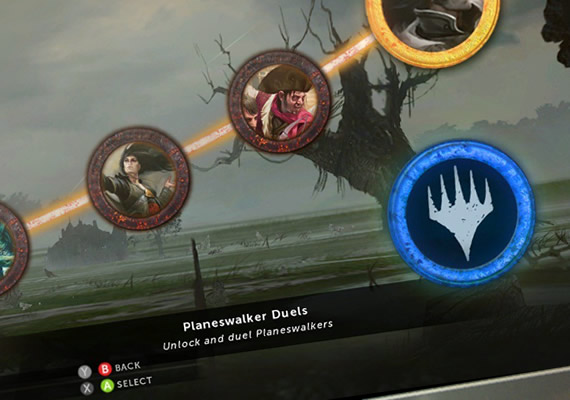Magic The Gathering 2014 Xbox 360 Review
Magic The Gathering 2014 is the successor to the 2013 edition of the game, and seeks to bring the new Ravnica expansion to the playing field complete with new card types and new features.
Campaign Mode
The Campaign Mode follows a similar format to 2013. You will play encounters, vs matches against other decks and Plainswalkers. Defeating your opponents gives you the ability to unlock new cards for your deck of choice.
Levels are split into “Plains”, which correspond to the Magic The Gathering expansions such as Innistrad, Alara and Ravnica and are laid out in a very visually appealing way.

You play a set number of encounters and opponents for each plain and once completed you advance to the next plain.
Encounters are basically a single mechanic or set play, such as your opponent playing one creature every turn or trying to execute a game winning combo before you defeat them. This mode is great for learning how your deck works and, more importantly, how it doesn’t.
Encounters often have an Achilles Heel, which can be exploited by the right deck/card. For example, using a card that removes all instances of a specific card that the encounter relies on will result in an easy-win.
After doing a few encounters you can then play a fully constructed deck like your own, sometimes these can be challenging and you would expect to play them several times before succeeding. When you beat a deck you unlock that deck, which is pretty much exactly what happens when you defeat the Plainswalkers decks.
Sealed Mode
Sealed Mode lets you build a deck from random cards acquired from booster packs. As you progress through this mode you are able to unlock more booster packs to get more cards and improve your deck.
You can also play Sealed Mode in multiplayer, which is a little more rewarding because you’ll have more involvement in your victory… even if your opponents opening hand was 1 land and 6 creatures with a converted mana cost of more than 5. Successful and strategic deck building is where a great deal of the strategy behind MTG is forged.
Although Sealed Play is a very watered down experience, it’s great to see elements from the real world of Magic The Gathering make their way into the game.
Like it or not, this mode should be welcomed, specially for those trying to learn to play MTG. Sealed Play is a great introduction into deck building, which is one of the most important factors of playing Magic in real life.
Puzzle Mode
Though the first puzzles are great for new players to understand some of the more technical tricks used in the game, they are almost pointless for a Magic player with an average amount of experience. However, the game makes up for this with more advanced puzzles which, like its predecessors, leave you scratching your head for a while. It’s worth the effort, though, because once you complete a puzzle you’ll often learn tricks you never knew.
The Good
It was great to see that detailed aspects of play had been visualised; such as exiled cards, and the number of cards in the graveyard. This saves the player from having to look at the graveyard and manually count the cards required for an ability to activate.
The music is brilliant, not just compared to the previous versions ( which was dull and uninspiring ) but compared to video-game music in general.
The menu screens and navigation are much more fluid than previous versions, and offer quicker ways to navigate. Coupled with faster loading times, you’re spending more time playing MTG and less time watching loading screens or negotiating your way through awkward interfaces.
Some of the rare cards, once zoomed in, have a fancy new feature; animated artwork. This was, admittedly, a delight to see for the first time. Card animations are subtle and well executed, adding a nice element to the game without any negative effect on gameplay.
You have lots of control over the settings. There are only so many times you want to see a combat animation before it becomes a hindrance. All aspects of the game can be tailored in great detail to fit around the way you like to play.
The Bed
Selecting from cards is awkward. For example, on more than one occasion when my opponent has cast “Path to Exile”, at the point I get to search my library for a basic land card I have somehow continued without selecting a land. I think the process is unclear and it’s easy to make mistakes. I did not have this problem in any of the previous titles.
When assigning damage to blockers I came across a little problem where one of the two oppositions blockers were enchanted with my enchantment, however because the border colour of both the blocker and the enchantment were the same, it was impossible to distinguish between the blocker with and without the enchantment.
There are various minor errors in AI judgement, such as not understanding how devastating destroying “Black Cat” can be, but this happens in real life I guess. I didn’t find anything too game breaking.
In conclusion…
Overall Magic The Gathering 2014 is a solid update on the original, bringing enough new features and enough refinement to make it a no-brainer for any Magic fan. For new players, this is a good point to get into the game, as 2014 covers more fundamental Magic The Gathering mechanics, is up-to-date with the latest expansions, is more fluid and generally better than any previous game.
Written by Ben Hamment